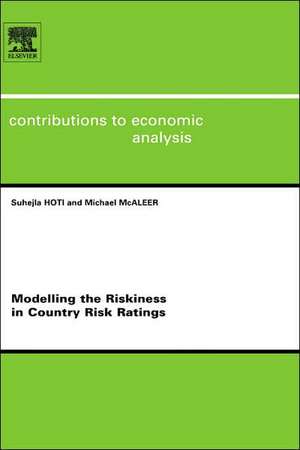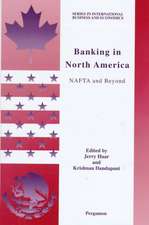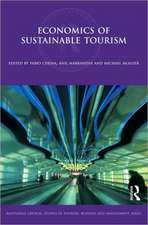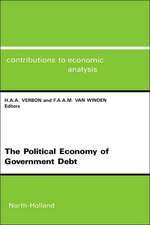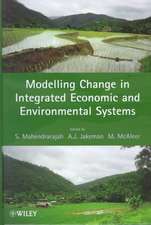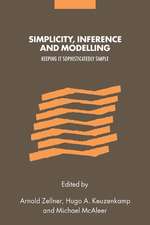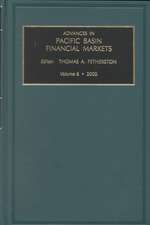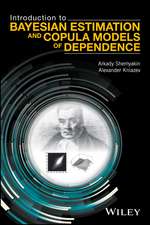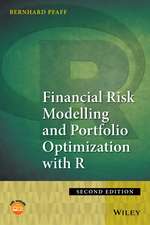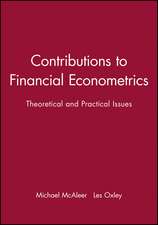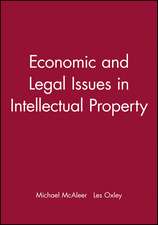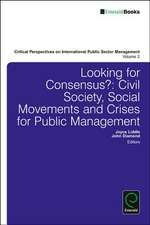Modelling the Riskiness in Country Risk Ratings: Contributions to Economic Analysis, cartea 273
Autor Suhejla Hoti, Michael McAleeren Limba Engleză Hardback – 22 apr 2005
Din seria Contributions to Economic Analysis
- 9%
 Preț: 802.39 lei
Preț: 802.39 lei - 23%
 Preț: 1071.35 lei
Preț: 1071.35 lei - 23%
 Preț: 1023.59 lei
Preț: 1023.59 lei - 23%
 Preț: 932.12 lei
Preț: 932.12 lei - 23%
 Preț: 1258.06 lei
Preț: 1258.06 lei - 23%
 Preț: 1125.47 lei
Preț: 1125.47 lei - 23%
 Preț: 1072.71 lei
Preț: 1072.71 lei - 23%
 Preț: 1134.25 lei
Preț: 1134.25 lei - 23%
 Preț: 1025.01 lei
Preț: 1025.01 lei - 23%
 Preț: 928.43 lei
Preț: 928.43 lei - 23%
 Preț: 1327.58 lei
Preț: 1327.58 lei - 23%
 Preț: 1090.22 lei
Preț: 1090.22 lei - 23%
 Preț: 1196.60 lei
Preț: 1196.60 lei - 23%
 Preț: 928.84 lei
Preț: 928.84 lei - 23%
 Preț: 1061.82 lei
Preț: 1061.82 lei - 23%
 Preț: 1113.58 lei
Preț: 1113.58 lei - 23%
 Preț: 874.46 lei
Preț: 874.46 lei - 19%
 Preț: 673.76 lei
Preț: 673.76 lei -
 Preț: 333.43 lei
Preț: 333.43 lei - 23%
 Preț: 1264.34 lei
Preț: 1264.34 lei - 23%
 Preț: 1323.45 lei
Preț: 1323.45 lei - 23%
 Preț: 1261.24 lei
Preț: 1261.24 lei - 23%
 Preț: 1099.44 lei
Preț: 1099.44 lei - 23%
 Preț: 1149.25 lei
Preț: 1149.25 lei - 23%
 Preț: 836.47 lei
Preț: 836.47 lei - 23%
 Preț: 854.99 lei
Preț: 854.99 lei - 23%
 Preț: 1125.37 lei
Preț: 1125.37 lei - 23%
 Preț: 932.57 lei
Preț: 932.57 lei - 23%
 Preț: 1266.20 lei
Preț: 1266.20 lei - 23%
 Preț: 1018.90 lei
Preț: 1018.90 lei - 23%
 Preț: 1204.17 lei
Preț: 1204.17 lei - 23%
 Preț: 1398.42 lei
Preț: 1398.42 lei - 23%
 Preț: 1299.72 lei
Preț: 1299.72 lei - 23%
 Preț: 1221.55 lei
Preț: 1221.55 lei - 23%
 Preț: 1134.89 lei
Preț: 1134.89 lei - 23%
 Preț: 928.43 lei
Preț: 928.43 lei - 23%
 Preț: 930.35 lei
Preț: 930.35 lei - 23%
 Preț: 1028.12 lei
Preț: 1028.12 lei - 23%
 Preț: 895.88 lei
Preț: 895.88 lei - 23%
 Preț: 1096.14 lei
Preț: 1096.14 lei - 23%
 Preț: 999.71 lei
Preț: 999.71 lei - 23%
 Preț: 1052.38 lei
Preț: 1052.38 lei - 23%
 Preț: 1045.56 lei
Preț: 1045.56 lei - 23%
 Preț: 1255.61 lei
Preț: 1255.61 lei - 23%
 Preț: 1076.51 lei
Preț: 1076.51 lei - 23%
 Preț: 1042.59 lei
Preț: 1042.59 lei
Preț: 1199.21 lei
Preț vechi: 1557.41 lei
-23% Nou
Puncte Express: 1799
Preț estimativ în valută:
229.49€ • 239.29$ • 190.73£
229.49€ • 239.29$ • 190.73£
Carte tipărită la comandă
Livrare economică 20 martie-03 aprilie
Preluare comenzi: 021 569.72.76
Specificații
ISBN-13: 9780444518378
ISBN-10: 0444518371
Pagini: 492
Dimensiuni: 155 x 232 x 25 mm
Greutate: 0.9 kg
Editura: Emerald Group Publishing Limited
Seria Contributions to Economic Analysis
ISBN-10: 0444518371
Pagini: 492
Dimensiuni: 155 x 232 x 25 mm
Greutate: 0.9 kg
Editura: Emerald Group Publishing Limited
Seria Contributions to Economic Analysis
Public țintă
Economists.Cuprins
Chapter one: Introduction . 1.1 Country risk. 1.2 Country risk literature. 1.3 Risk ratings and rating systems.
1.4 Risk ratings and risk returns for 120 representative countries.
1.5 Conditional volatility models for risk ratings and risk returns.
1.6 Empirical results.
1.7 Conclusion.
Chapter two: Country risk models: An empirical critique.
2.1 Introduction.
2.2 Classification of the data.
2.3 Theoretical and empirical model specifications.
2.4 Empirical findings.
2.5 Conclusion.
Appendices to chapter two.
2.1Description of models.
2.2Analysis of models.
Chapter three: Rating risk rating systems.
3.1 Introduction.
3.2 Risk rating industry.
3.3 Comparison of country risk rating methodologies.
3.4 ICRG country risk ratings
3.5 Conclusion.
Chapter four: Assessment of risk ratings and risk returns for 120 representative countries.
4.1 Introduction.
4.2 One-hundred and twenty selected countries.
4.3 Risk ratings, risk returns and volatilities.
4.3.1 Central and South Asia.
4.3.2 East Asia and the Pacific.
4.3.3 East Europe.
4.3.4 Middle East and North Africa.
4.3.5 North and Central America.
4.3.6 South America.
4.3.7 Sub-Saharan Africa.
4.3.8 West Europe.
4.4 Conclusion.
Appendix to chapter four.
4.1ICRG classification of countries by starting date and geographic region.
Chapter five: Conditional volatility models for risk ratings and risk returns.
5.1 Introduction.
5.2 Univariate conditional volatility models.
5.3 An asymmetric varma-garch model.
5.4 Conclusion.
Chapter six: univariate and multivariate estimates of symmetric and asymmetric. conditional volatilities and conditional correlations for risk returns.
6.1 Introduction and recommendations for foreign investors.
6.2 Univariate models.
6.2.1 Central and South Asia region: garch(1,1) and gjr(1,1) estimates.
6.2.2 East Asia and the Pacific region: garch(1,1) and gjr(1,1) estimates.
6.2.3 East Europe region: garch(1,1) and gjr(1,1) estimates.
6.2.4 Middle East and North Africa region: garch(1,1) and gjr(1,1) estimates.
6.2.5 North and Central America region: garch(1,1) and gjr(1,1) estimates.
6.2.6 South America region: garch(1,1) and gjr(1,1) estimates.
6.2.7 Sub-Saharan Africa region: garch(1,1) and gjr(1,1) estimates.
6.2.8 West Europe region: garch(1,1) and gjr(1,1) estimates.
6.3 Multivariate models: Static conditional correlations.
6.3.1 Central and South Asia region: Static conditional correlation estimates.
6.3.2 East Asia and the Pacific region: static conditional correlation estimates.
6.3.3 East Europe region: static conditional correlation estimates.
6.3.4 Middle East and North Africa region: static conditional correlation estimates.
6.3.5 North and Central America region: Static conditional correlation estimates.
6.3.6 South America region: Static conditional correlation estimates.
6.3.7 Sub-Saharan Africa region: Static conditional correlation estimates.
6.3.8 West Europe: Static conditional correlation estimates.
6.4Summary: Static conditional correlation estimates.
6.5 Conclusion.
Chapter seven: Conclusion.
7.1 Summary of the monograph.
7.2 Future research.
7.2.1 Alternative methods, models and data.
7.2.2 New research directions.
7.3 Conclusion.
1.4 Risk ratings and risk returns for 120 representative countries.
1.5 Conditional volatility models for risk ratings and risk returns.
1.6 Empirical results.
1.7 Conclusion.
Chapter two: Country risk models: An empirical critique.
2.1 Introduction.
2.2 Classification of the data.
2.3 Theoretical and empirical model specifications.
2.4 Empirical findings.
2.5 Conclusion.
Appendices to chapter two.
2.1Description of models.
2.2Analysis of models.
Chapter three: Rating risk rating systems.
3.1 Introduction.
3.2 Risk rating industry.
3.3 Comparison of country risk rating methodologies.
3.4 ICRG country risk ratings
3.5 Conclusion.
Chapter four: Assessment of risk ratings and risk returns for 120 representative countries.
4.1 Introduction.
4.2 One-hundred and twenty selected countries.
4.3 Risk ratings, risk returns and volatilities.
4.3.1 Central and South Asia.
4.3.2 East Asia and the Pacific.
4.3.3 East Europe.
4.3.4 Middle East and North Africa.
4.3.5 North and Central America.
4.3.6 South America.
4.3.7 Sub-Saharan Africa.
4.3.8 West Europe.
4.4 Conclusion.
Appendix to chapter four.
4.1ICRG classification of countries by starting date and geographic region.
Chapter five: Conditional volatility models for risk ratings and risk returns.
5.1 Introduction.
5.2 Univariate conditional volatility models.
5.3 An asymmetric varma-garch model.
5.4 Conclusion.
Chapter six: univariate and multivariate estimates of symmetric and asymmetric. conditional volatilities and conditional correlations for risk returns.
6.1 Introduction and recommendations for foreign investors.
6.2 Univariate models.
6.2.1 Central and South Asia region: garch(1,1) and gjr(1,1) estimates.
6.2.2 East Asia and the Pacific region: garch(1,1) and gjr(1,1) estimates.
6.2.3 East Europe region: garch(1,1) and gjr(1,1) estimates.
6.2.4 Middle East and North Africa region: garch(1,1) and gjr(1,1) estimates.
6.2.5 North and Central America region: garch(1,1) and gjr(1,1) estimates.
6.2.6 South America region: garch(1,1) and gjr(1,1) estimates.
6.2.7 Sub-Saharan Africa region: garch(1,1) and gjr(1,1) estimates.
6.2.8 West Europe region: garch(1,1) and gjr(1,1) estimates.
6.3 Multivariate models: Static conditional correlations.
6.3.1 Central and South Asia region: Static conditional correlation estimates.
6.3.2 East Asia and the Pacific region: static conditional correlation estimates.
6.3.3 East Europe region: static conditional correlation estimates.
6.3.4 Middle East and North Africa region: static conditional correlation estimates.
6.3.5 North and Central America region: Static conditional correlation estimates.
6.3.6 South America region: Static conditional correlation estimates.
6.3.7 Sub-Saharan Africa region: Static conditional correlation estimates.
6.3.8 West Europe: Static conditional correlation estimates.
6.4Summary: Static conditional correlation estimates.
6.5 Conclusion.
Chapter seven: Conclusion.
7.1 Summary of the monograph.
7.2 Future research.
7.2.1 Alternative methods, models and data.
7.2.2 New research directions.
7.3 Conclusion.
